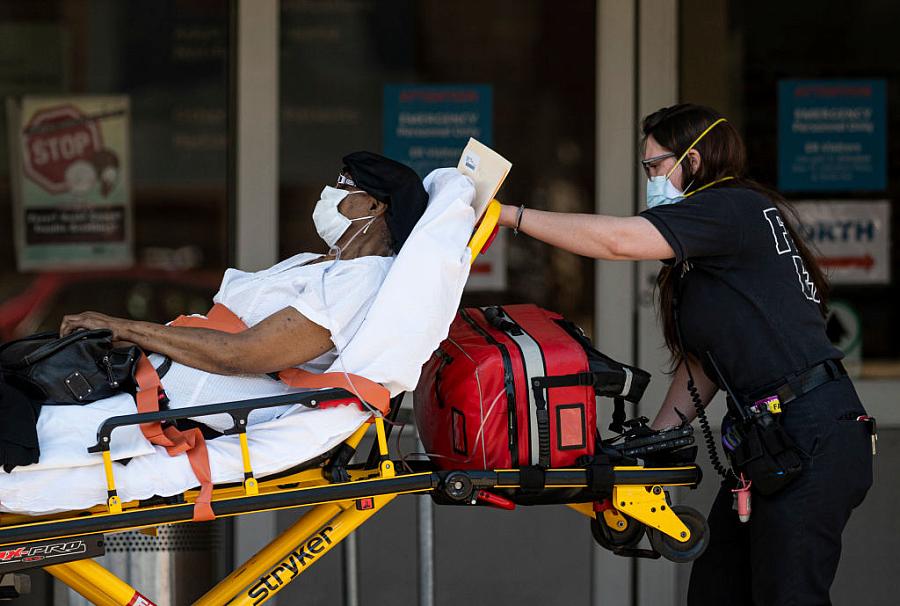How to start reporting on implicit bias in your local health system

Medical workers transport a patient at Maimonides Medical Center on May 17 in Brooklyn.
(Photo by Johannes Eisele/Getty Images)
As part of its “You Asked, We Answered” series, the Center for Health Journalism has been asking journalists what questions they have about reporting on COVID-19. This week's question: “How can journalists ID how implicit bias is affecting care in their towns, cities and locales that they’re reporting on?” — Curious in the Bay Area
Besides working as a health policy reporter for USA Today, Jayne O’Donnell also operates a nonprofit, the Urban Health Media Project, where she works with high school students of color on medical stories affecting their communities.
So she has both written stories — and heard from her students — about minorities receiving substandard health care and subsequently avoiding the medical system altogether.
After she was furloughed the first week of the protests over the police killing of George Floyd, she said she was “ready Monday” to write about the intersection of racial bias and health care in America.
Her USA Today story with Ken Alltucker, published June 15, tells of how structural racism has infected the medical system long before COVID-19 came along, and how these disparities have been exacerbated by the pandemic. Data suggests that Black and Hispanic people in America are more likely to both contract and die from the coronavirus than their white counterparts.
We want to hear your questions about covering COVID-19 — scroll down and tell us or ask your question here!
Her reporting hits on one of the reasons for these racial discrepancies: implicit bias, or when people assign stereotypes to others without even being conscious of it. The Centers for Disease Control and Prevention has recommended that health care providers identify and address any of these biases they may have as a way to reduce COVID-related disparities.
So how can other reporters find out if racial bias is affecting medical care in their communities?
“It’s an issue everywhere,” O’Donnell said. “It’s really about taking the time to talk to people.”
For story leads, she recommends reaching out to patient safety groups — she cited the Patient Safety Action Network Community and the Patient Safety Movement as examples — or checking the Leapfrog Group’s hospital ratings to see how facilities serving minority populations fare.
“Journalists can work with their local health care institutions and ask about health disparities in their communities and health care disparities in their hospitals,” suggested Dr. Malika Fair, senior director for health equity partnerships and programs for the American Association of American Medical Colleges. “Some hospitals may make some de-identified data publicly available as well as their internal strategy to address inequities when they are found.”
Nao Hagiwara, an associate professor of psychology at Virginia Commonwealth University, says reporters could look at community-level data from Project Implicit, an organization that studies implicit bias, and compare it to local coronavirus statistics.
“One can examine if communities with higher levels of aggregated implicit bias ... are also the communities with greater racial disparities in COVID-19 morbidity, mortality, or both,” she said. “I would not be surprised if any social psychologists have started to test this particular hypothesis.”
Hagiwara said journalists could also observe patient-provider interactions to see if race and ethnicity seem to play a role (though she noted this could be a tough sell to doctors and hospitals because of HIPPA concerns). She noted that researchers have been able to identify medical bias by viewing video-recorded doctor appointments — and that it doesn’t take that long to register these dynamics.
“This, I believe, suggests that journalists would be able to ‘feel’ the difference at the global level — friendly, engaged, awkward, compassionate, etc. — by simply observing providers interacting with patients from diverse racial or ethnic backgrounds,” she said.
Melva Thompson-Robinson, director of the Center for Health Disparities Research at the University of Nevada-Las Vegas, said reporters could also examine local numbers of coronavirus-related referrals and waiting times to see if they differ by race.
“When you start noticing those differences in care, that’s when you need to dig deeper and ask questions,” she said.
She suggested news organizations could also find two people — of different races but with suspected cases of COVID-19 — who go to the same doctor’s office or hospital and track the type of medical care each one receives.
She said journalists should make sure that they don’t let their own implicit biases affect their reporting. (Anyone can take Project Implicit’s implicit association test for free, online.)
For instance, she said that, as the economy reopens, reporters should be wary of being overly rosy when reporting on the declining unemployment rate when it’s actually increasing for African Americans.
And journalists should be careful not to assign blame when reporting on minority groups not seeking medical care, when there might be logistical reasons at play. For example, many people in her city, Las Vegas, work all hours of the night and might not be able to go to a clinic that’s only open during regular business hours.
“All of us really need to be looking at ourselves and checking ourselves as we’re dealing with each other and as we’re creating systems and coming out of COVID,” she said, adding: “How do we not get back into the same situation?”
**

